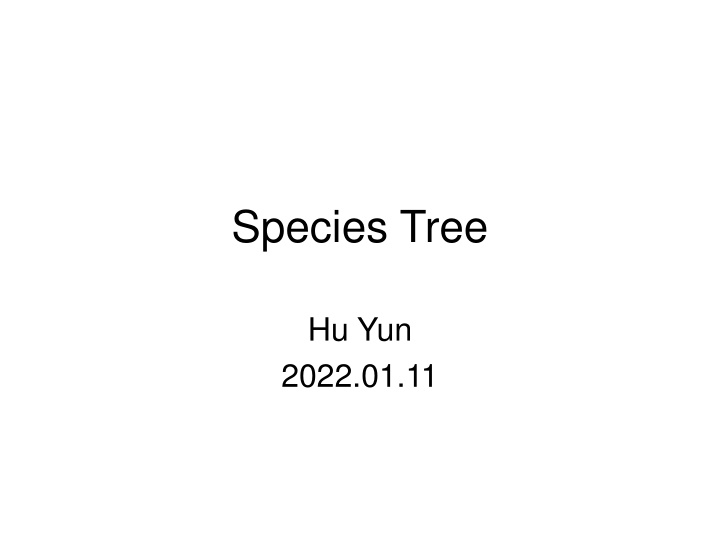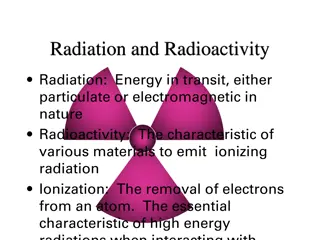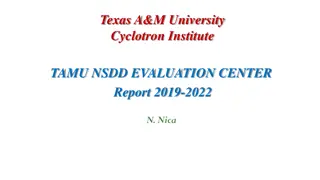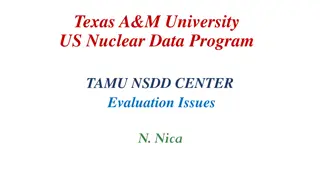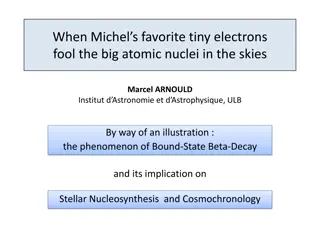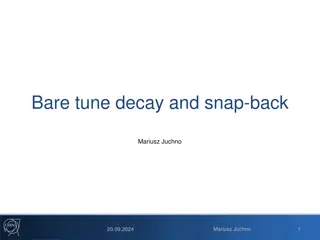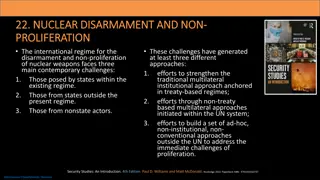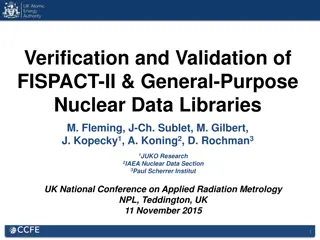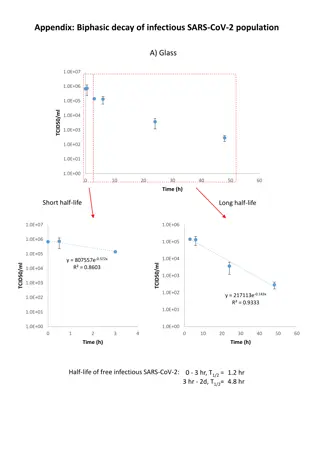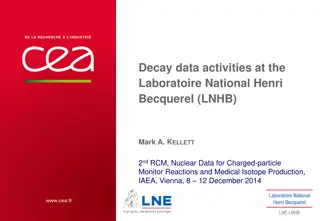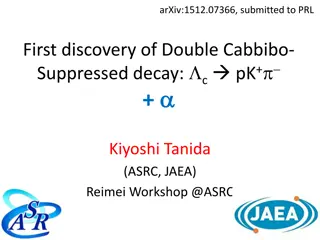Nuclear Structure and Decay Data Evaluation Activities at ANU (2013-2015)
Activities conducted at the Australian National University (ANU) related to nuclear structure and decay data evaluations from 2013 to 2015 are highlighted in this report. The report covers mass chain evaluations, atomic radiations of medical radioisotopes, collaborations with various institutions, and publications resulting from the research. It also mentions the implementation of new protocols and tools like BrIcc and AVETOOLS RULER GABS at ANU.
Download Presentation

Please find below an Image/Link to download the presentation.
The content on the website is provided AS IS for your information and personal use only. It may not be sold, licensed, or shared on other websites without obtaining consent from the author.If you encounter any issues during the download, it is possible that the publisher has removed the file from their server.
You are allowed to download the files provided on this website for personal or commercial use, subject to the condition that they are used lawfully. All files are the property of their respective owners.
The content on the website is provided AS IS for your information and personal use only. It may not be sold, licensed, or shared on other websites without obtaining consent from the author.
E N D
Presentation Transcript
Species Tree Hu Yun 2022.01.11
Catalogs compare gene tree and species tree Incomplete lineage sorting (ILS) ASTRAL
Phylogeny for three species ABC and six genes that stem from a gene duplication resulting in two paralogous clades of genes, and . The genes 123 are orthologous with each other, as are the genes 456; however each gene is paralogous with each gene as they are separated by a gene duplication event, not a speciation event.
3 1 5 C A B
Species trees should contain sequences from only orthologous genes.
Conception Species tree: phylogeny that displays a sequence of speciation events
When we build a phylogenetic tree with orthologous genes, it's a species tree, right?
Incomplete lineage sorting (ILS) refers to the phenomenon that phylogenetic trees based on a single gene are inconsistent with those based on species.
ASTRAL a fast method for estimating species trees from multiple genes. provides a statistically consistent estimation of the true species tree from unrooted gene trees, under the multi- species coalescent model.
Tree error is measured using the Robinson Foulds(RF) (Robinson and Foulds, 1981) rate; because all trees estimated here are completely bifurcating( ), this is the same as the missing branch rate (proportion of internal edges in the model tree missing in the estimated tree)
(A) shows results under default levels of ILS, varying the number of genes and gene tree resolution;
(B) shows results under increased ILS levels, varying the number of genes, and on both true gene trees and estimated gene trees
(C)shows results on 200 genes, varying the amount of ILS from very low (5x species tree branch lengths) to very high (0.2x species tree branch lengths)
ASTRAL For 4 species, the dominant quartet topology is the species tree
For >4 species, the dominant topology may be different from the species tree 1. Break up input each gene tree into ? 4trees on 4 taxa (quartet trees) 2. Find all ? topologies 3. Combine dominant quartet trees 4dominant quartat
ASTRAL with >4 speices 1.Break up input each gene tree into ? (quartet trees) 4trees on 4 taxa A B C D A D A B C D B C E E E Number of gene tree 10 5 1
1.Break up input each gene tree into ? (quartet trees) 4trees on 4 taxa A B C D A D A B C D B C E E E Number of gene tree 10 5 1 (A,B),(C,D)
1.Break up input each gene tree into ? (quartet trees) 4trees on 4 taxa A B C D A D A B C D B C E E E Number of gene tree 10 5 1 (A,B),(C,D) (B,C),(D,E)
1.Break up input each gene tree into ? (quartet trees) 4trees on 4 taxa A B C D A D A B C D B C E E E Number of gene tree 10 5 1 (A,D),(B,C) (A,D),(B,E) (A,D),(C,E) (A,B),(C,E) (B,D),(C,E) (A,B),(C,D) (B,C),(D,E) (A,C),(D,E) (A,B),(D,E) (A,B),(C,E) (B,C),(A,D) (A,B),(D,E) (A,E),(B,C) (B,C),(D,E) (A,C),(D,E)
1.input each gene tree into ? trees) 4trees on 4 taxa (quartet A B C D A D A B C D B C E E E Number of gene tree 10 5 1 (A,D),(B,C) (A,D),(B,E) (A,D),(C,E) (A,B),(C,E) (B,D),(C,E) (A,B),(C,D) (B,C),(D,E) (A,C),(D,E) (A,B),(D,E) (A,B),(C,E) (B,C),(A,D) (A,B),(D,E) (B,C),(A,E) (B,C),(D,E) (A,C),(D,E)
2. Find all ? 4dominant quartat topologies Compute the total number of times each resolved quartet was found over all input gene tree Resolved quartet (A,B),(C,D) (B,C),(D,E) (A,C),(D,E) (A,B),(D,E) (A,B),(C,E) (B,C),(A,D) (A,E),(B,C) (B,D),(C,E) (A,D),(B,E) (A,D),(C,E) Induced by tree(s) Weight 1 1+2 1+2 1+2 1+3 2+3 2 3 3 3 10 10+5=15 15 15 11 6 5 1 1 1
ASTRAL with >4 speices A B C D Score=10+11+15+15+15=66 E A B C D Score=15+15+15+6+5=56 E
3.ASTRAL with >4 speices A B C D Best tree Score=10+11+15+15+15=66 E A B C D Score=15+15+15+6+5=56 E
USAGES java -jar astral.5.7.5.jar -i <input file> -o <output file> java -jar astral.5.7.5.jar #find more parameters about astral -i <input file> a file containing input gene trees in newick format.(required) -o <outgroup> choose a single species to be used as outgroup display puropses only -r <replicates> Set the number of bootstrap replicates done in multi-locus bootstrapping. (default: 100) -d <trimming threshold> the closer user's estimate is, the faster astral runs (default: 0) for
